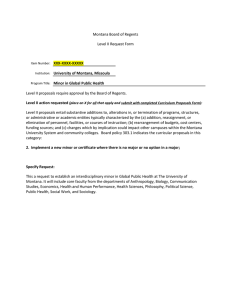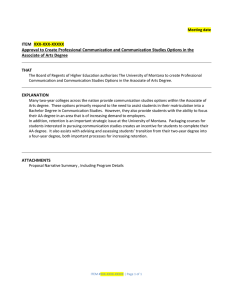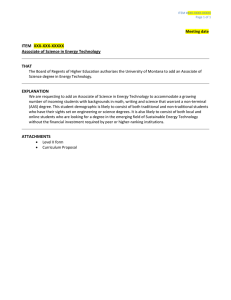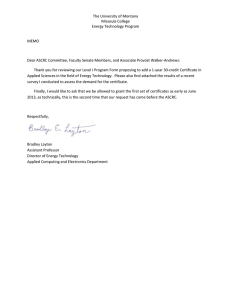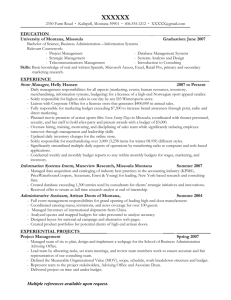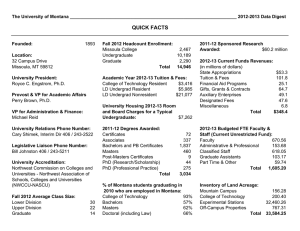Montana Board of Regents C P
advertisement
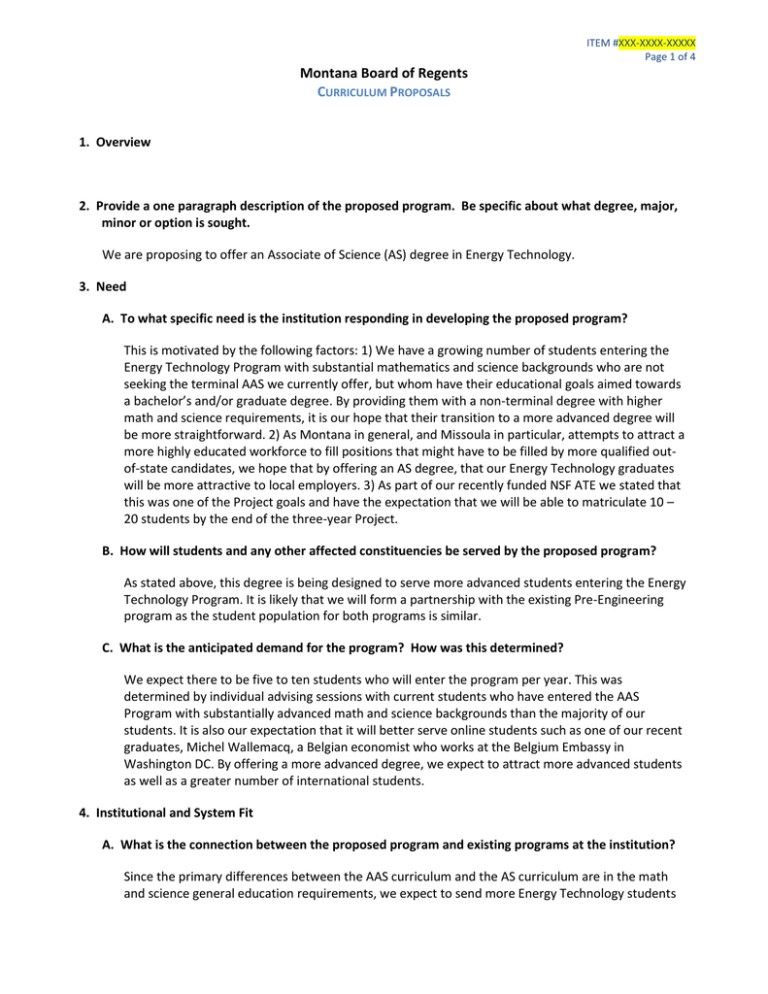
ITEM #XXX-XXXX-XXXXX Page 1 of 4 Montana Board of Regents CURRICULUM PROPOSALS 1. Overview 2. Provide a one paragraph description of the proposed program. Be specific about what degree, major, minor or option is sought. We are proposing to offer an Associate of Science (AS) degree in Energy Technology. 3. Need A. To what specific need is the institution responding in developing the proposed program? This is motivated by the following factors: 1) We have a growing number of students entering the Energy Technology Program with substantial mathematics and science backgrounds who are not seeking the terminal AAS we currently offer, but whom have their educational goals aimed towards a bachelor’s and/or graduate degree. By providing them with a non-terminal degree with higher math and science requirements, it is our hope that their transition to a more advanced degree will be more straightforward. 2) As Montana in general, and Missoula in particular, attempts to attract a more highly educated workforce to fill positions that might have to be filled by more qualified outof-state candidates, we hope that by offering an AS degree, that our Energy Technology graduates will be more attractive to local employers. 3) As part of our recently funded NSF ATE we stated that this was one of the Project goals and have the expectation that we will be able to matriculate 10 – 20 students by the end of the three-year Project. B. How will students and any other affected constituencies be served by the proposed program? As stated above, this degree is being designed to serve more advanced students entering the Energy Technology Program. It is likely that we will form a partnership with the existing Pre-Engineering program as the student population for both programs is similar. C. What is the anticipated demand for the program? How was this determined? We expect there to be five to ten students who will enter the program per year. This was determined by individual advising sessions with current students who have entered the AAS Program with substantially advanced math and science backgrounds than the majority of our students. It is also our expectation that it will better serve online students such as one of our recent graduates, Michel Wallemacq, a Belgian economist who works at the Belgium Embassy in Washington DC. By offering a more advanced degree, we expect to attract more advanced students as well as a greater number of international students. 4. Institutional and System Fit A. What is the connection between the proposed program and existing programs at the institution? Since the primary differences between the AAS curriculum and the AS curriculum are in the math and science general education requirements, we expect to send more Energy Technology students ITEM #XXX-XXXX-XXXXX Page 2 of 4 Montana Board of Regents CURRICULUM PROPOSALS to courses such as calculus, physics and chemistry, the majority of which are offered on Mountain Campus. B. Will approval of the proposed program require changes to any existing programs at the institution? If so, please describe. No. C. Describe what differentiates this program from other, closely related programs at the institution (if appropriate). As stated above, perhaps the closest related program is the Pre-engineering program. The main aspects of the AS in Energy Technology that differentiate it from pre-engineering is that the ASET offers more technology-specific coursework. D. How does the proposed program serve to advance the strategic goals of the institution? 1. This certificate will strengthen Missoula College ties with the University of Montana by exposing a greater number of Missoula College students to the mathematics and science courses taught within the College of Humanities and Sciences as we “Partner for Student Success,” by preparing them for 4-year degrees as well as graduate degrees. 2. This degree will also provide a pathway towards “Education for the Global Century” which promised to require greater technical skills and within the context of liberal education. 3. By equipping our Energy Technology students with the tools of calculus and the concepts inherent in the physical sciences in conjunction with the many hands-on learning experiences for students pursuing this degree, we will create a more “Dynamic Learning Environment.” By providing this new two-year degree option for students, it will allow us to fine-tune and diversify the Energy Technology Program as part of its “Planning-Assessment Continuum.” E. Describe the relationship between the proposed program and any similar programs within the Montana University System. In cases of substantial duplication, explain the need for the proposed program at an additional institution. Describe any efforts that were made to collaborate with these similar programs; and if no efforts were made, explain why. If articulation or transfer agreements have been developed for the substantially duplicated programs, please include the agreement(s) as part of the documentation. The only similar program is the AAS in Energy Technology currently offered at Missoula College. We are already partnered with other two-year colleges through our current DOL TAACCCT SWAMMEI project and have made every effort to invite our consortium colleagues to encourage their students to enroll in our diverse course offerings. 5. Program Details A. Provide a detailed description of the proposed curriculum. Where possible, present the information in the form intended to appear in the catalog or other publications. NOTE: In the case of two-year degree programs and certificates of applied science, the curriculum should ITEM #XXX-XXXX-XXXXX Page 3 of 4 Montana Board of Regents CURRICULUM PROPOSALS include enough detail to determine if the characteristics set out in Regents’ Policy 301.12 have been met. The Associate of Science degree in Energy Technology is designed to be a non-terminal degree for students wishing to pursue a Bachelor of Science degree or higher. Students in the Energy Technology Program are introduced to the full suite of energy sources and technologies. Graduates will be practitioners that are equipped with skills in design, installation, and maintenance of diverse energy technologies and systems; sales, operations, and management; regulatory compliance; basic electricity and power systems; energy storage and distribution; site assessment; basic energy economics; efficiency and conservation strategies; and project management. With its more rigorous STEM requirements, students are prepared to enter engineering programs. Students may enter the program in either autumn or spring term. B. Describe the planned implementation of the proposed program, including estimates of numbers of students at each stage. We propose to begin offering this degree Autumn 2016 with an expected enrollment of approximately five students. Our anticipation is that we will enroll between five and ten students per year thereafter. 6. Resources A. Will additional faculty resources be required to implement this program? If yes, please describe the need and indicate the plan for meeting this need. No. Missoula College students who have sufficient math and science skills will take their Gen Ed math and science courses on Mountain Campus or online where possible. B. Are other, additional resources required to ensure the success of the proposed program? If yes, please describe the need and indicate the plan for meeting this need. No. 7. Assessment How will the success of the program be measured? We will measure success by enrollment, retention, matriculation, and employment statistics. We are also optimistic that by partnering more strongly with the College of Humanities, Arts and Sciences that we will continue to build upon the improving relationship between Missoula College and The University of Montana. 8. Process Leading to Submission Describe the process of developing and approving the proposed program. Indicate, where appropriate, involvement by faculty, students, community members, potential employers, accrediting agencies, etc. ITEM #XXX-XXXX-XXXXX Page 4 of 4 Montana Board of Regents CURRICULUM PROPOSALS This degree program was discussed extensively with Cathy Corr as well as other Associate of Science committee members. It has also been discussed with ASCRC members and reviewed and approved by a National Science Foundation Advanced Technology Education review committee.
